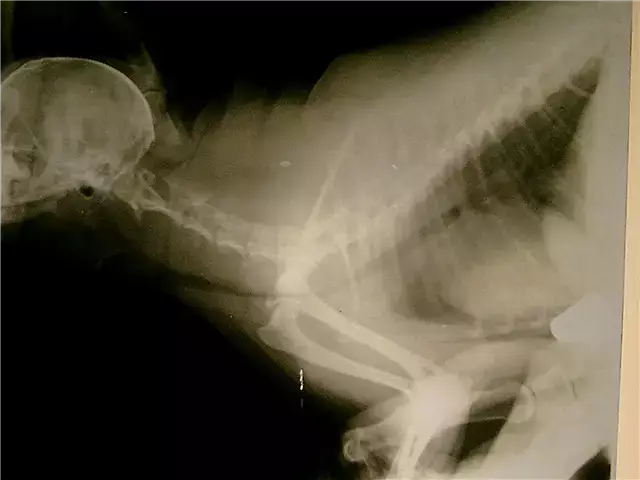- Author Rachel Wainwright [email protected].
- Public 2023-12-15 07:39.
- Last modified 2025-11-02 20:14.
Phenylbutazone
Instructions for use:
- 1. Pharmacological action
- 2. Release form
- 3. Indications for use
- 4. Contraindications
- 5. Instructions for use
- 6. Side effects
Phenylbutazone is an analgesic, anti-inflammatory and antipyretic agent.
pharmachologic effect

The drug belongs to the group of non-steroidal anti-inflammatory drugs from the butadione group.
Its mechanism of action is associated with an indiscriminate effect on tissue enzymes - type 1 and type 2 cyclooxygenases. Cyclooxygenase is found in the endothelium (inner lining) of blood vessels. Phenylbutazone blocks its action, as a result of which the formation of prostaglandins from arachidonic acid is disrupted. Prostaglandins belong to a group of compounds that can cause inflammatory reactions in the body. By reducing their formation, Phenylbutazone has antipyretic, anti-inflammatory and analgesic effects. On the strength of the anti-inflammatory effect, it surpasses Aspirin.
It is known about the properties of Phenylbutazone to enhance the excretion of uric acid from the body.
When taking the medicine inside, the maximum content of the active substance in the blood is detected after 2 hours. The conversion of Phenylbutazone occurs in the liver. Excretion from the body is carried out by the kidneys and intestines, partially in an unchanged state.
Phenylbutazone release form
According to the instructions, Phenylbutazone is released in the form of tablets of 150 mg, ointments for external use, 15% and 20% solution for injection in ampoules.
Indications for the use of Phenylbutazone
Oral medicine is prescribed for diseases such as erythema nodosum, chorea minor, rheumatism, nonspecific infectious and psoriatic polyarthritis. It must be remembered that this is a reserve anti-inflammatory agent, it is used in case of ineffectiveness of other drugs and only for a short course. Best of all, the anti-inflammatory effect is manifested in ankylosing spondylitis and gout.
As an adjuvant, the drug is sometimes used in the treatment of arthrosis and synovitis.
Local application of Phenylbutazone ointment helps with dermatitis from mechanical stress, minor burns of 1 - 2 degrees, including sunburn, with stretching of tendons, muscles, insect bites.
Contraindications
According to the instructions, phenylbutazone should not be taken orally in case of hypersensitivity to it and other NSAIDs, in case of severe renal or hepatic insufficiency, inhibition of the hematopoietic system (including leukopenia), with exacerbation of duodenal ulcer and stomach ulcer, ulcerative colitis, and cardiovascular insufficiency in the stage of decompensation. The ointment is not applied in case of violation of the integrity of the skin, eczema, trophic ulcers.
Phenylbutazone can be used in adults and children over the age of 14.
Use the drug with caution in diseases of the central nervous system, with gastritis, it can provoke bleeding. During treatment, in order to avoid fluid retention in the body, it is recommended to limit the use of table salt.
Prescription of the drug during pregnancy and lactation is possible only under the supervision of a physician, weighing the risk / benefit ratio for the fetus and the child.
Instructions for the use of Phenylbutazone
Phenylbutazone in the form of tablets is taken orally during a meal or immediately after it, with water.

The adult dose is 100 - 150 mg 2 - 3 times a day (maximum 600 mg / day). As soon as the clinical effect is achieved, the dose should be immediately reduced to 200 mg / day.
Children's dosage, depending on age, is 10-100 mg in 3-4 divided doses.
The ointment is applied in a thin layer to intact skin 2 to 3 times a day.
Injections are intended only for the relief of acute manifestations of gout, rheumatoid arthritis, chorea minor.
When taken simultaneously with indirect anticoagulants, sulfonamides and antidiabetic agents, their effect is enhanced. Phenylbutazone can affect concentration and reaction speed.
Due to the deterioration of blood flow in the kidneys, the drug reduces the effectiveness of diuretics and antihypertensive drugs.
Side effects
Phenylbutazone often causes adverse effects. Up to 45% of patients report a violation of hematopoiesis (aplastic anemia, leukopenia), dyspepsia in the form of nausea, abdominal pain, vomiting, diarrhea, neuritis, ulcers and erosions in the digestive tract, the presence of blood in the urine.
Information about the drug is generalized, provided for informational purposes only and does not replace the official instructions. Self-medication is hazardous to health!






